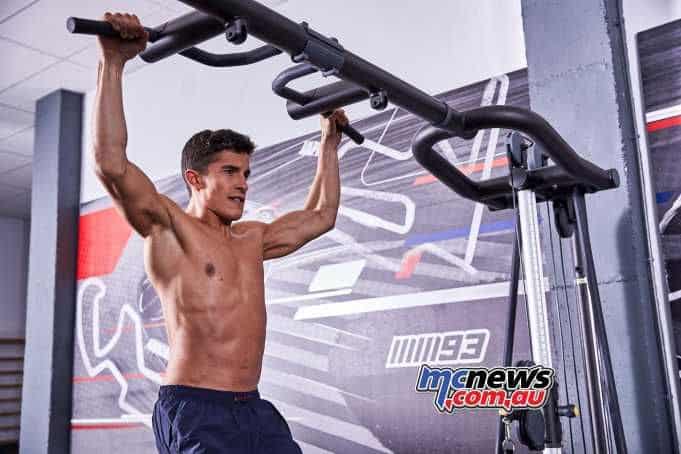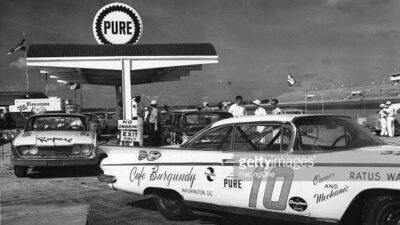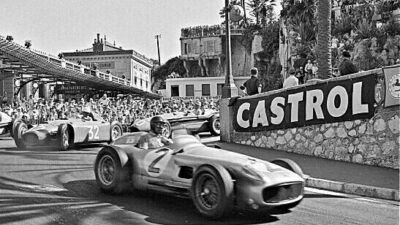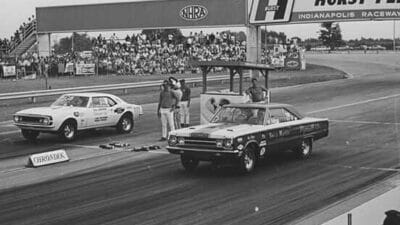When watching MotoGP riders lean into corners at incredible speeds, most fans don’t realize the extreme physical demands these athletes face during competition. MotoGP riders train up to six hours per day during the off-season, focusing on cardiovascular fitness, strength training, and specialized exercises to handle forces up to 3.4 times their body weight through approximately 240 corners per race. This level of preparation goes far beyond what most people imagine for motorcycle racing.
The physical challenges these riders encounter are unlike any other motorsport. They must control 300+ horsepower machines while experiencing massive g-forces during braking and acceleration. MotoGP riders need supreme fitness levels to maintain control and focus throughout races that can last over 40 minutes of intense physical strain.
A rider’s training program involves much more than just riding motorcycles. Their routines include specific strength exercises, cardio conditioning, and mental preparation that changes throughout the racing calendar. Most riders work out six days a week with different focuses depending on whether it’s preseason, racing season, or the summer break.
Key Takeaways
- MotoGP riders experience forces up to 3.4 times their body weight and must train six hours daily during off-season to handle these extreme physical demands
- Training programs include cardiovascular conditioning, strength exercises with kettlebells and dumbbells, and specialized movements that mirror riding positions
- Mental preparation and nutrition strategies are equally important as physical training for maintaining peak performance throughout the grueling racing season
Physical Demands Unique to MotoGP
MotoGP racing places extreme physical stress on riders through high-speed cornering, intense g-forces, and precise bike control for extended periods. The sport demands exceptional cardiovascular fitness, core strength, flexibility for extreme lean angles, and lightning-fast reflexes.
Endurance Requirements
A typical MotoGP race lasts 40-45 minutes at speeds exceeding 200 mph. Riders must maintain peak focus and physical control throughout this duration.
Heart rates during races reach 160-180 beats per minute. This level matches marathon runners despite the shorter time frame. The constant adrenaline and physical exertion create enormous cardiovascular demands.
MotoGP riders require rigorous cardiovascular training to build the endurance needed for race conditions. Their training includes long cycling sessions, running, and swimming.
Dehydration becomes a major concern during races. Riders can lose 2-4 pounds of body weight through sweat in a single race. This weight loss affects concentration and reaction times.
The physical stress continues beyond individual races. A typical season includes 20+ race weekends with practice sessions, qualifying, and races. This schedule requires sustained fitness levels throughout the year.
Strength and Core Stability
Modern MotoGP bikes generate over 300 horsepower and create massive forces during acceleration, braking, and cornering. Riders need significant upper body and core strength to control these machines.
Core muscles work constantly to maintain body position during extreme lean angles and direction changes. A weak core leads to fatigue and poor bike control.
Arms and shoulders face particular stress during braking zones. Riders experience forces up to 1.5g while decelerating from 200+ mph to 60 mph in seconds.
The physical training focuses heavily on strength to handle motorcycle demands. Weight training, resistance exercises, and functional movements build the necessary muscle power.
Grip strength becomes critical for maintaining control of the handlebars. Riders train with specialized equipment to build forearm and hand strength.
Flexibility for Lean Angles
MotoGP riders achieve lean angles exceeding 60 degrees during cornering. These extreme positions require exceptional flexibility in hips, ankles, and spine.
The knee-down riding position demands significant hip flexibility. Riders must stretch their inside leg out while maintaining balance and control.
Ankle mobility allows riders to maintain proper foot position on the pegs during extreme lean angles. Limited ankle flexibility restricts cornering ability and increases crash risk.
Riders keep their bodies supple for speed through daily stretching routines. Yoga and dynamic stretching exercises maintain the necessary range of motion.
Spinal flexibility enables riders to shift their body weight effectively. Quick transitions between left and right corners require fluid spine movement.
Reaction Time and Mental Acuity
MotoGP racing happens at incredible speeds where split-second decisions determine success or failure. Reaction times must be faster than 0.2 seconds in emergency situations.
Visual processing becomes critical when following other riders at 180+ mph. Riders must track multiple bikes while planning overtaking moves and identifying braking points.
Mental fatigue affects physical performance during races. The constant adrenaline and concentration demands exhaust mental resources quickly.
Training includes specific exercises for reaction time and cognitive function. Video games, reaction drills, and simulator work sharpen mental responses.
Hand-eye coordination training helps riders make precise control inputs while processing track information. This skill becomes essential during wheel-to-wheel racing situations.
Cardio-Respiratory Conditioning
MotoGP riders need strong hearts and lungs to handle the physical demands of racing. Cardio-respiratory training forms the cornerstone of their fitness programs, especially during the pre-season months.
Cycling and Swimming Workouts
Road cycling serves as the primary cardio exercise for most MotoGP riders. Riders like Pedrosa focus heavily on bicycle training to build stamina during the off-season.
Cycling mimics the leg strength needed for controlling a motorcycle. The seated position also matches the racing stance riders maintain for extended periods.
Swimming provides full-body conditioning without joint stress. It builds lung capacity while strengthening core muscles that riders use to grip the bike.
Key Benefits:
- Improves oxygen delivery to muscles
- Builds leg and core strength
- Reduces injury risk through low-impact training
MotoGP riders start training before dawn with these cardio activities. They often spend hours on bikes covering many miles to prepare their cardiovascular systems.
Interval and Endurance Training
High-intensity interval training pushes riders’ heart rates to race conditions. Short bursts of maximum effort followed by recovery periods train the body for quick accelerations and sudden braking.
Endurance sessions build the stamina needed for full race distances. Riders must maintain focus and physical control throughout races that can last over 40 minutes.
Training Schedule:
- Pre-season: 6 days per week, December to March
- Racing season: Reduced volume, maintenance focus
- Off-season: Active recovery with varied sports
The training intensity matches race demands. Heart rates during MotoGP races often exceed what athletes experience in other sports, requiring exceptional cardiovascular fitness.
Strength and Functional Training
MotoGP riders develop exceptional upper body and core strength to control 300+ horsepower motorcycles through extreme lean angles and G-forces. Flexibility training ensures riders can move fluidly across their bikes while maintaining control through demanding corner sequences.
Upper Body and Core Focus
A MotoGP rider’s upper body endures intense strain during races. Riders experience forces up to 3.4G through approximately 240 corners during a single race.
Core Stability Exercises:
- Raider planks (3-minute holds)
- Fitball twists with hip rotation
- Quadruped rows on benches
The raider plank specifically targets the muscles needed for bike control. Riders place one leg on an elevated surface while supporting their body weight on their hands and the other leg for three minutes.
Weight training and isokinetic exercises form the foundation of strength development. During preseason, riders train up to six hours daily, six days per week.
Essential Equipment:
- 8-10 kg dumbbells
- 10-12 kg kettlebells
- Stability fitballs
- Exercise mats
Side lunges with kettlebell lifts build the lateral strength needed for extreme lean angles. This exercise mimics the sideways forces riders experience when cornering at speed.
Flexibility Routines
Flexibility allows MotoGP riders to shift their body position smoothly during cornering. Tight muscles restrict movement and reduce control at high speeds.
Dynamic Warm-up Sequence:
- High kicks every ten feet
- Lunges with twists
- Knee-to-chest pulls
- Single leg deadlifts
- Bent knee lateral swings
These movements prepare joints for the extreme positions required during racing. A MotoGP rider must maintain flexibility in their hips, shoulders, and spine to achieve proper lean angles.
Joint flexibility prevents stiffness that limits position changes across the bike. Riders perform these routines before every training session and race weekend.
Strategic flexibility training continues throughout the racing season. The exercises focus on maintaining range of motion in key muscle groups used during cornering and bike control.
Stretching routines target the neck, back, and leg muscles that experience the most stress during races.
Mental Training and Race Preparation
MotoGP riders develop lightning-fast reflexes through specialized drills and use advanced visualization techniques to prepare their minds for the intense pressure of racing at speeds exceeding 200 mph.
Reflex and Decision-Making Drills
MotoGP riders train their minds to react in milliseconds during high-speed situations. They use computer simulations and video games designed specifically for racing to sharpen their decision-making skills.
Reaction Time Training:
- Light-based reflex drills
- Hand-eye coordination exercises
- Split-second decision scenarios
Professional riders practice overtaking scenarios repeatedly in controlled environments. They memorize track layouts and study potential passing zones before each race weekend.
The pressure of maintaining focus during crucial moments requires constant mental conditioning. Riders work with sports psychologists to develop strategies for managing adrenaline surges during races.
Emergency response drills help prepare riders for unexpected situations. They practice brake failure scenarios, tire blowouts, and sudden weather changes through mental exercises.
Visualization and Focus Techniques
Top MotoGP riders spend hours visualizing perfect race lines and successful overtaking maneuvers. They mentally rehearse every corner, braking point, and acceleration zone before hitting the track.
Common Visualization Methods:
- Track walkthroughs: Mental mapping of each circuit
- Race scenarios: Practicing different race situations
- Performance imagery: Visualizing successful outcomes
Many riders use meditation and breathing exercises to control their adrenaline levels. These techniques help them stay calm during intense wheel-to-wheel racing situations.
Professional sports psychologists work closely with riders to develop personalized mental training programs. Each motogp rider learns specific focus techniques tailored to their racing style and mental strengths.
Pre-race routines include visualization sessions where riders mentally experience the entire race. They practice maintaining concentration for the full 45-minute race duration while managing physical fatigue.
Nutrition, Hydration, and Recovery Strategies
MotoGP riders follow strict dietary plans that fuel their bodies for optimal performance while maintaining proper hydration and recovery protocols. These strategies help riders endure the physical demands of racing 300-horsepower motorcycles at extreme speeds.
Balanced Diet Principles
MotoGP riders need specific nutrients to handle the intense physical demands of racing. Carbohydrates stand out as optimal fuel to take on the hardest weeks of training. These provide the energy needed for both training sessions and race days.
Key Nutritional Components:
- High protein intake for muscle repair and maintenance
- Complex carbohydrates for sustained energy during races
- Adequate fats for hormone production and joint health
Riders like the Espargaró brothers follow largely vegetable-based diets that focus on water storage. They choose foods that contain good quantities of water to support hydration.
Proper nutrition aids in repairing muscle tissue and reducing recovery time. This becomes critical when riders face back-to-back race weekends and intense training schedules.
Hydration for Peak Performance
Water consumption plays a vital role in rider performance and safety. Dehydration can significantly impact performance and pose serious risks to rider health.
Riders face unique hydration challenges during races. They wear full leather suits in hot conditions while maintaining focus for 45 minutes or more. Sweat loss can reach dangerous levels without proper preparation.
There are rules in place for water consumption during races, and riders must have strategies in place to stay hydrated. Teams develop specific hydration protocols for each track and weather condition.
Pre-race hydration starts 24-48 hours before the event. Riders increase fluid intake while monitoring urine color to gauge hydration status.
During races, limited opportunities exist for fluid replacement. Most hydration must occur before the race begins.
Recovery and Injury Prevention
Recovery strategies help riders bounce back from the physical strain of controlling powerful motorcycles. The intense physical strain of riding necessitates rapid muscle recovery.
Sleep forms the foundation of recovery. Riders typically need 8-9 hours of quality sleep to allow muscle repair and mental recovery.
Active recovery includes light exercise, stretching, and mobility work on rest days. This helps maintain flexibility and prevents muscle stiffness.
Nutrition timing becomes crucial for recovery. Riders consume protein and carbohydrates within 30 minutes after training or racing. This window allows for optimal muscle glycogen replenishment.
Injury prevention focuses on maintaining flexibility and strength balance. Regular massage, physiotherapy, and targeted exercises address the repetitive stress from motorcycle racing.
Fabio Quartararo and other top riders work closely with nutritionists and physiotherapists. They customize recovery protocols based on individual needs and race schedules.
A MotoGP Rider’s Training Calendar
A MotoGP rider’s training regimen follows a structured yearly cycle that adapts to the racing season’s demands. The calendar divides into three distinct phases that focus on building peak fitness, maintaining performance during competition, and allowing for recovery.
Pre-Season Preparation
MotoGP riders prepare for the new season through intense physical conditioning that begins 12-16 weeks before the first race. This period focuses on building the foundation for race-day performance.
Physical Training Schedule:
- Weeks 1-6: Base fitness building with 6-7 training days per week
- Weeks 7-12: Intensity increases with sport-specific exercises
- Weeks 13-16: Peak conditioning and race simulation
Riders start their day before dawn during pre-season training. Morning sessions typically include 60-90 minutes of cardio work like cycling or swimming.
Afternoon training focuses on strength work and reaction time drills. Riders spend 2-3 hours on motorcycle-specific exercises that prepare their bodies for the physical stress of racing.
Mental preparation also begins during this phase. Riders work with sports psychologists to develop focus techniques and stress management skills.
In-Season Adaptations
The racing calendar runs from March through November, requiring riders to maintain peak fitness while competing. Training volume decreases but intensity remains high throughout this period.
Weekly Training Structure:
- Race weeks: 3-4 training sessions focused on maintenance
- Non-race weeks: 5-6 sessions with moderate intensity
- Back-to-back races: Specialized preparation protocols
Recovery becomes the top priority during race weekends. Riders focus on light cardio and stretching between practice sessions and races.
Travel schedules create unique challenges for maintaining fitness routines. Most riders pack portable equipment and work with trainers who travel with the team.
Nutrition timing becomes critical during the season. Riders follow strict meal schedules that align with practice sessions and races.
Off-Season and Rest Periods
The off-season typically lasts 10-12 weeks from late November through early February. This period balances active recovery with preparation for the upcoming season.
Off-Season Structure:
- Weeks 1-3: Complete rest with minimal physical activity
- Weeks 4-8: Light training to maintain basic fitness
- Weeks 9-12: Gradual return to structured training
Riders incorporate rest days throughout their routine to prevent overtraining and injury. Mental recovery receives equal attention during this phase.
Many riders use the off-season to address any physical issues or injuries from the racing season. Physical therapy and corrective exercises help prepare the body for another demanding year.
Cross-training activities like skiing, surfing, or other sports help maintain fitness while providing mental refreshment. These activities also help develop different muscle groups and movement patterns.
Insights from Elite MotoGP Riders
Top MotoGP riders like Fabio Quartararo have revolutionized training methods by focusing on specific muscle groups and maintaining optimal power-to-weight ratios. Modern riders also incorporate off-track motorcycle training to sharpen their skills beyond race weekends.
Fabio Quartararo’s Evolving Approach
Fabio Quartararo reveals his training strategies focus on being the strongest at the lightest weight possible. The 2021 MotoGP World Champion trains his upper body in the gym while using cardio work for his legs.
His approach adapts to each track’s demands. Quartararo explains that tracks with many left turns require extra tricep and upper body preparation.
Core areas of focus:
- Triceps and core strength for all tracks
- Upper body power for specific circuit demands
- Cardio endurance through leg-focused exercises
The French rider works with nutritionists who provide weekly meal schedules based on his training load. Blood tests help determine which supplements he needs.
Quartararo allows himself treats like ice cream after dinner. His nutritionist supports this freedom because it helps him mentally during the long racing season.
Despite 11 surgeries and a severely fractured wrist, he maintains that proper recovery doesn’t affect long-term training. His injury experience has taught him the importance of smart rehabilitation methods.
Training with Motorcycles Off the Track
MotoGP riders incorporate specific motorcycling drills into their training routines alongside traditional fitness work. These motorcycle-based exercises help riders maintain their connection to the bike between race weekends.
Riders use smaller motorcycles and dirt bikes to practice different riding techniques. This type of training helps them stay sharp with bike control and balance.
Benefits of off-track motorcycle training:
- Improved bike handling skills
- Better balance and coordination
- Muscle memory maintenance
- Reaction time sharpening
Many riders train on supermoto bikes because they offer similar lean angles and cornering challenges. The lighter weight allows for more practice sessions without excessive physical strain.
Track days on different circuits help riders experience various corner types and surface conditions. This variety prepares them for the diverse challenges they face during the racing calendar.
Some riders also use indoor motorcycle simulators to practice specific tracks before race weekends. These tools help them learn racing lines and braking points without the physical demands of actual riding.
Frequently Asked Questions
MotoGP riders follow specific workout plans that focus on core strength and endurance training. They also work on mental preparation and follow strict eating plans to stay in top shape.
What types of physical exercises are included in a MotoGP rider’s fitness routine?
MotoGP riders focus heavily on core strength to maintain control of their powerful motorcycles at high speeds. This muscle group helps them stay stable during sharp turns and sudden changes in direction.
Upper body and arm strength training are key parts of their workout plans. Riders need strong arms and shoulders to handle the massive forces that pull on them during races.
Weight training includes exercises like leg presses and squats to build lower body power. Strong legs help riders grip the bike with their knees and maintain proper riding position.
Endurance training keeps riders sharp throughout long races. They do cardio workouts to build the stamina needed for races that can last over 40 minutes.
Agility drills help riders react quickly to sudden changes on the track. These exercises improve their balance and coordination skills.
How do MotoGP riders train to improve their mental toughness and focus?
Mental preparation plays a huge role in MotoGP training programs. Riders work with sports psychologists to develop focus techniques that help them stay calm under pressure.
The psychological side is very important in individual sports like motorcycle racing. Teams spend significant time helping riders build mental strength.
Visualization exercises help riders practice race scenarios in their minds. They imagine different track conditions and practice making split-second decisions.
Meditation and breathing techniques help riders stay relaxed during high-stress moments. These skills are crucial when racing at speeds over 200 mph.
Mental training also includes studying race footage and analyzing mistakes. This helps riders learn from past experiences and improve their decision-making skills.
How often do MotoGP riders train both on and off the track?
MotoGP riders train year-round with different schedules for racing season and off-season periods. Their training never completely stops, even during breaks.
During the racing season, riders balance track time with gym workouts. They typically train 5-6 days per week when not at race weekends.
The summer break includes a month-long period where riders modify their training based on specific areas they want to improve. This break happens halfway through the racing season.
Off-season training looks similar to pre-season preparation. Riders increase their gym time and focus more on building strength and endurance.
Track training includes practice sessions, testing new bike setups, and learning new circuits. Riders spend dozens of hours on their motorcycles each month during active periods.
What kind of diet plan do MotoGP riders follow to maintain peak physical condition?
MotoGP riders follow carefully planned eating schedules designed by nutrition experts. Their diets focus on providing steady energy throughout long training sessions and races.
Protein intake helps riders build and maintain the muscle mass needed for motorcycle control. They eat lean meats, fish, and plant-based protein sources throughout the day.
Carbohydrates provide the fuel riders need for intense physical activity. They choose complex carbs that give sustained energy rather than quick sugar spikes.
Hydration plays a crucial role since riders lose significant fluids during races in hot weather. They drink water and electrolyte solutions before, during, and after training.
Diet and exercise work together to keep riders in peak physical condition throughout the demanding racing season.
What role does technology and data analysis play in a MotoGP rider’s training regimen?
Heart rate monitors track riders’ fitness levels during workouts and races. This data helps trainers adjust exercise intensity to match specific goals.
Bike telemetry provides detailed information about riding technique and performance. Riders study this data to find areas where they can improve their lap times.
Video analysis breaks down riding positions and techniques frame by frame. Coaches use this footage to help riders make small adjustments that lead to big improvements.
GPS tracking shows exact speeds and lines through different corners. Riders compare their data with teammates to learn faster racing techniques.
Fitness tracking apps monitor sleep quality, recovery time, and training loads. This information helps prevent overtraining and reduces injury risk.
How is a MotoGP rider’s training regimen tailored to their individual needs and racing style?
Each rider works with personal trainers who understand their specific strengths and weaknesses. Training plans focus on improving areas that need the most work.
Riding style affects which muscles need the most development. Aggressive riders might need more upper body strength, while smooth riders focus on endurance.
Some riders modify their training programs during breaks to target specific focus areas. This personalized approach helps address individual challenges.
Body type influences exercise selection and training intensity. Taller riders might need different core exercises than shorter competitors.
Repsol riders include various activities like running, motocross, and water sports in their routines. This variety keeps training interesting while building different types of fitness.
Previous injuries require modified exercise programs to prevent re-injury. Trainers adapt workouts to work around any physical limitations riders might have.












